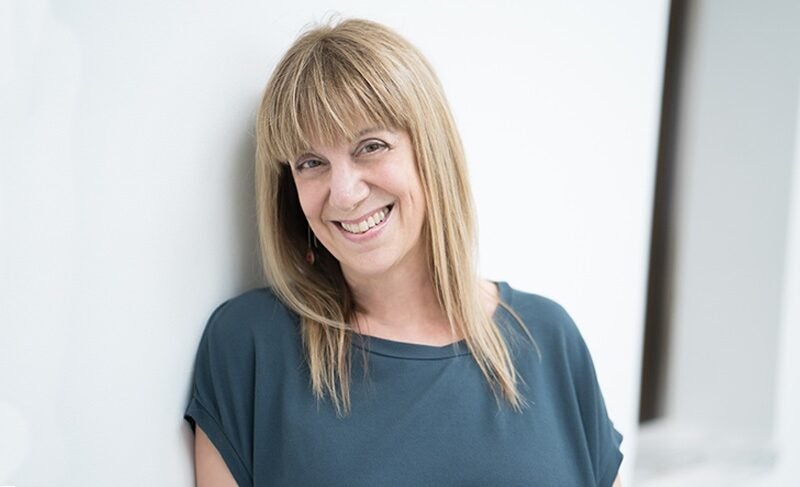
In this episode, Doctoral candidate Samantha Oliver speaks with Professor Monroe Price and artist Cornelia Thomsen about the opening of an exhibit Imagery Narrative Propaganda Artists in the German Democratic Republic located on the 5th floor of the Annenberg School for Communication at the University of Pennsylvania.
TRANSCRIPT
Aaron Shapiro: Welcome to Media at Risk. Podcast from the Center for Media at Risk at the Annenberg School for Communication, at the University of Pennsylvania. In this episode, Annenberg Doctoral candidate Samantha Oliver speaks with Monroe Price and Cornelia Thomsen for the opening of an exhibit of Soviet era art from East Germany. The pieces in the exhibit come from Monroe’s personal collection, and Cornelia speaks to the challenges in climate that artists in East Germany faced. Hope you enjoy.
Samantha Oliver: Hi, my name is Samantha Oliver and I’m a 6th year PhD student at the Annenberg School for Communication, at the University of Pennsylvania. Today I’m chatting with Monroe Price and Cornelia Thomsen ahead of the opening of an exhibit entitled Imagery Narrative Propaganda Artists in the German Democratic Republic. Monroe Price is an adjunct full professor here at Annenberg and holds additional appointments at the Cardozo School of Law, Stanhope Centre for Communication and Policy Research and Central European University. Cornelia Thomsen is an artist and curator who spent the first 20 years of her life living in East Germany where she developed a passion for the visual arts. She currently resides in New York where she co-founded a gallery specializing in Japanese art and continues to display her artwork through a variety of exhibition shows and catalogs.
Samantha Oliver: The prints and drawings featured in this exhibition come from the collection of Monroe and Aimée Brown Price. These works were produced by artists living in the shadow of the German Democratic Republic, the socialist political regime that governed East Germany from 1949 until 1990. The exhibition addresses numerous themes, including everyday life and the GDR, anti-fascism, the role of women in society, the celebration of economic achievement and political satire. Guiding the exhibition are the core questions: How did the arts function as a vital medium in the German Democratic Republic? And what can an engagement with the visual arts tell us about issues of media and risk?
Samantha Oliver: First, could you start by telling us a little bit about how you came to acquire the pieces that make up the exhibition and what your motivation or inspiration was for collecting these works?
Monroe Price: Well, first of all, I have a kind of interest in collecting. It’s unclear what this interest is. Partly it was because my wife is an art historian, and I needed some occupation as I went to museums all over the world. I needed something that satisfied me, so I got interested in collecting in the areas which I was visiting. This particular collection of work started with an ICA meeting in Dresden.
Samantha Oliver: The International Communication Association annual conference.
Monroe Price: I came across the work of an extraordinary woman named Renate Geisberg-Wichmann, who wasn’t East German, and I started buying her work on eBay and through that I came in contact with a kind of dealer in Leipzig who was selling off eastern art work. And so he would sell 20 or 30 works a week and I would wake up on Tuesday morning, to see the launch of it and then I would bid on his work, and et cetera. So why was I interested in that? Because I’m interested in propaganda. I’m interested in questions of purpose of artists, and this work seemed to envelop those kinds of issues.
Samantha Oliver: And what do you think these themes can tell us about artistic production under the GDR? What can we learn from engaging with these kinds of works?
Monroe Price: One of the questions here is how the artist felt in terms of his or her role with respect to society. One of the things that’s intriguing to me in preparing this exhibition was the way in which the West articulated the output of East German artists, often trivializing it, marginalizing it, et cetera, on the ground that it was mere propaganda, or it wasn’t art. The issue isn’t is it art or not? It’s not how it speaks to us. But it’s how we understand how it spoke to them. It’s a very complicated question, and so many people evaluate East German art, evaluate on how it speaks to us then or now, as opposed to how it functions within a society.
Cornelia Thomsen: I grew up in East Germany for the first 19 years of my life. There I always loved painting and drawing.
Samantha Oliver: This is Cornelia, who delivered a talk to accompany the exhibition’s opening.
Cornelia Thomsen: When I grew up, the world was completely different from anything else you can imagine. To cover the free time and the loneliness I had, I picked up a pencil and made drawings and became good at it, had some talent. I kept on doing it and could create my own world besides the rest of what I had to do. My interest was always in portrait painting, maybe because this was also the official state form. Portrait painting had a long tradition in European art history. To be able to make a living, I went to Meissen Porcelain Company, Meissen near Dresden, where I attended a four year apprenticeship, where I could combine all of it and in East Germany you could not plan ahead or have an international career because you were bound by the borders, and you had to make wise decisions how to live. Artistic production had a function in East Germany; it had to represent the ideas of socialism. If you wanted to make a living or become famous, you had to just work with the government…
Voiceover: Oil paintings of working heroes, state sanctioned art that boldly idealizes communism.
Monroe Price: A lot of the functions were state related functions. So, for example, how to underscore the idea, false or correct, that East Germany was peace loving and West Germany was redolent of fascism.
Cornelia Thomsen: If you tried to create your own works, your own ideas, you had no chance to be become visible in the state, and there were underground artists who had really interesting ideas, but they just never had a chance to be seen. The official painters learned or found a way to imply their thoughts in theatrical themes, for instance, and sent messages out to the people, who would then very early figure out what they meant.
Monroe Price: In my view, almost everything is propaganda. So the question is where does it verge from mere narrative to something which is designed specifically to help shape the ideas of the society in a kind of promotional way. And so I think almost all the works in this exhibit have propaganda elements in them, and important elements in them. Let’s take the question of how do you want to think of the artist as itself an element of propaganda. It’s so significant and so important for the West to think of the artist as an individual engaged in acts of individual autonomy and agency and et cetera. And in that respect, anything that falls away from that is oppressive, and restrictive, and wrong. So this whole question of how to conceptualize who the artist is as opposed to a worker in the arts who has some function related to the development of society seems to me very much involved in the exhibition.
Cornelia Thomsen: Everything I do is very closely related to my upbringing. For instance, when I studied later on in Frankfurt, I looked for something that was different to figurative art or to Meissen Porcelain decoration, and I found a professor who taught abstract art.
Voiceover: Whereas abstract art became dominant in West Germany, in the East painting remained overwhelmingly representational.
Cornelia Thomsen: Which I had known before, because it was the official art form of the oppressive world, and in the east, we pretty much focused on realistic painting. And so there I found a medium where I could reinvent myself. There was really a strong movement of self-censorship, because you had to be careful, because you had no choice to go anywhere, and you had to make sure that you would not get kicked out of the country or be imprisoned for what you said. And it was really a thin margin that you had to walk on, and you could try and maybe you succeeded, but it was always dangerous. East German art is often recognizable by its … That you have to look at it twice to understand it. It’s not loud, it’s not like popping out right in your face, you have to be careful and immerse yourself in it.
Monroe Price: One question that’s raised by this is whether there’s a risk of not being related to your society. That is to say, it’s the converse risk that the artists, that the notion of autonomy is so embedded, that there is no tie, no sense of purpose and function, that it has dignity. Not serving a society in a way other than exercising freedom and creating images, which are beautiful or interesting et cetera. Is there a risk that way? So we always think of risks in the other direction. The risk that artists will be restricted, artists will be censored, artists will be stopped in their tracks, but I guess this exhibit in some of the East German experiments asks is there a risk of being too dissociated?
Cornelia Thomsen: Yeah. You see in the early prints that are shown in the show that they deal with World War II, with the Holocaust, with the lowest and harmful experiences people can have, and how they try to through illustration or through art making to work with it and work through it. And later on you see how in this exhibition, how the people, how the artists depict socialism in a heroic form more and more, and it’s always very connected to the time when those prints were made, what people would say and how they would say it. People who lived in that system had to deal with it, but they were still thinking people, and they had their ideas and dreams and hopes, and applied them into the artworks. The painters and artists in East Germany never looked at themselves as workers and farmers, but this was the official idea of socialism, everyone would be equal. And so there was like a hierarchy in the system, and they had a special position, but they always had to be conformed somehow with the officials.
Samantha Oliver: How do you think these themes and these understandings can speak to present day context, present day political environments, what’s going on in society today?
Monroe Price: I think we begin to see this now, in artists thinking that they have a function and duty, the thing that’s called the resistance, for example. It’s not about freedom and autonomy of the artist, it’s about banding together and doing things in furtherance of a goal, which in this sense is recapturing democratic values or liberal values. And in that sense, the question is what do we learn about how this happens in the society, and the extent to which it’s tainted by too much state controller, controlled by other groups. It’s the lifelong problem of collective autonomy, as they say. Groups being independent, but in furtherance of a purpose for society. It should be independent of the corporation, it could be independent of large capital or independent of the state. The question here was independence from the state and still being in the function of society. We have a need for collective identities, and we have a need for artists or art workers who help us develop those kinds of ideas.
Aaron Shapiro: Thanks for listening. We’d like to think of Monroe and Aimée Brown Price, Cornelia Thomsen, Waldo Aguirre, Samantha Oliver and Emily Plowman. Barbie Zelizer is the Director of the Center for Media at Risk. For more information, check out www.ascmediarisk.org.
MUSIC
“All the Right Things” by Son Lux (intro)
“Do You Remember” by Ane Brun
“Silhouettes (I, II, & III)” by Floating Points
“Hasenheide” by Dieter Moebius
“Tiny Tortures” by Flying Lotus
“Rode Null” by Hauschka
“Two Fish and an Elephant” by Khruangbin (outtro)
FEEDBACK
We’d love to hear from you, especially if you have stories about this podcast, our Center and anything in between. Feel free to write a note or record a voice memo on your smartphone and email it to media.risk@asc.upenn.edu; you can also find us on Twitter and Facebook at @ASCMediaRisk. Though we’re a small operation, we’re always open to pitches and new stories.
CREDITS
Monroe E. Price is an Adjunct Full Professor at the Annenberg School for Communication and the Joseph and Sadie Danciger Professor of Law and Director of the Howard M. Squadron Program in Law, Media and Society at the Cardozo School of Law. He directs the Stanhope Centre for Communications Policy Research in London, and is the Chair of the Center for Media and Communication Studies of the Central European University in Budapest. As the founder and former director of Center for Global Communication Studies, Price has worked with a wide transnational network of regulators, scholars, and practitioners in Europe, Africa, Latin America, and Asia as well as in the United States. Under his direction, CGCS engaged in public opinion research in Sudan, providing technical assistance in Jordan and Thailand, encouraging the intelligent development of media policies and new information technologies in a wide variety of settings including Thailand and Somaliland. Price founded the Programme in Comparative Media Law and Policy at Oxford University and remains a Research Fellow there. CGCS also fostered the Stanhope Center for Communications Policy Research, located at the London School of Economics.
Cornelia Thomsen spent the first 20 years of her life in East Germany, where she developed her passion for drawing, painting, and piano from an early age. She was selected to attend several specialized art and music programs, advancing her technique and ultimately being accepted to the Meissen Porcelain Company in Saxony, where she trained and worked as a porcelain painter. After the reunification of Germany, Cornelia Thomsen studied at the University of Art and Design in Offenbach/Main Germany. In 2006, she moved from the Frankfurt area to New York with her husband and three children, where she co-founded the Erik Thomsen Gallery, which specializes in Japanese art. Simultaneously, she published multiple series of artworks through exhibitions, shows, and catalogues, including “Garden,” “Stripes and Structures”, and “Strokes” series. She has also focused on researching and working with post-war German history in her in her “Role Models” series and through talks given at institutions including The University of Chicago and the UN in New York. Cornelia Thomsen is currently represented by the Leslie Feely Gallery in New York, at Kashima Arts in Tokyo, and Felix Ringel Gallery in Düsseldorf.
This episode was produced by Samantha Oliver and edited by Aaron Shapiro.


